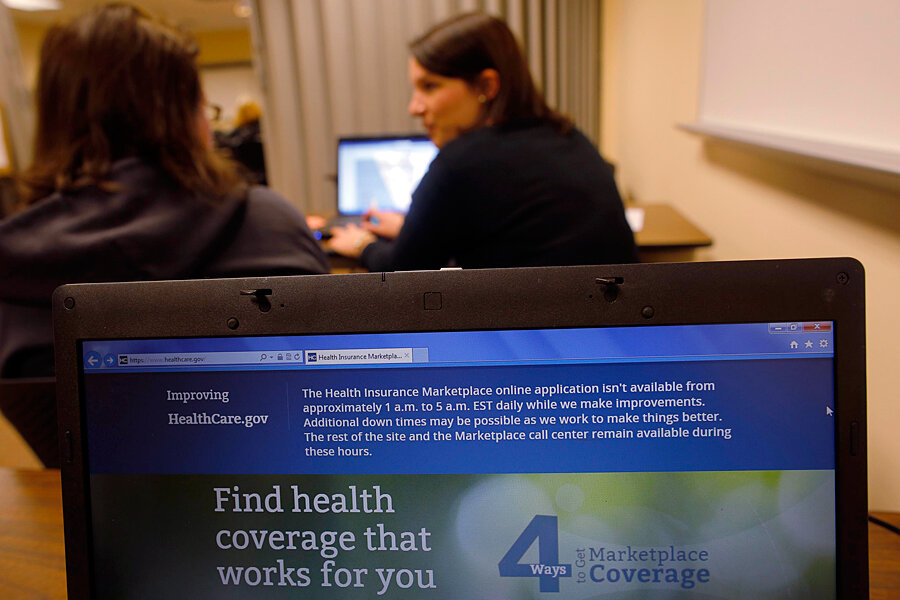Low Obamacare enrollment numbers: Sign of problems to come?
Loading...
The White House had expected Obamacare to have a flood of customers by this point, some six weeks after HealthCare.gov opened for business. But so far, that flood has been more of drip – not even a trickle. Only about 40,000 people have signed up for health insurance through the 36 state exchanges run by the federal government, according to a report in The Washington Post.
The Affordable Care Act goal for October was 500,000 enrollees. Wow. Obviously the technical problems plaguing the sign-up website are taking a huge toll. Is this as big a disaster as it seems?
We’d say no and yes, depending on what aspect of the new Obamacare system you’re looking at.
The “no” part is due to the fact that the 40,000 figure, which was first reported by The Wall Street Journal, undercounts what’s really going on. As we noted, it’s a figure from the states that have opted to not run their own insurance marketplaces, or exchanges. That forces the Feds to do it for them.
Fourteen states, plus the District of Columbia, chose to run their exchanges themselves. Twelve of these states have enrolled an additional 49,100 people, according to an estimate from Avalere Health, a market analysis firm.
Plus, the exchanges are only one prong of a two-prong Obamacare strategy to cover more of America’s uninsured. The other is the expansion of Medicaid. Those with incomes up to 138 percent of the federal poverty level – $15,856 for an individual or $32,499 for a family of four – are now eligible for Medicaid coverage in states that have agreed to go along with this coverage extension.
A total of 25 states are participating in Medicaid expansion. (A US Supreme Court ruling allows states to reject federal funds for this purpose.) So far, there are 440,000 new Medicaid enrollees in only 10 of these states, according to an Avalere Health estimate.
Add up these numbers, and you’ve got about 530,000 Obamacare enrollees of one type or another.
Does that mean they’re actually hitting their October half-a-million goal?
Not necessarily. The 500,000 figure comes from a letter cited last month by Rep. Dave Camp (R) of Michigan, chairman of the House Ways and Means Committee. It’s not clear whether it's meant to refer to all enrollees, or exchange enrollees alone, according to the Post.
Given the continued struggles of the electronic enrollment system, this might be a moot point in any case. That brings us to the “yes” part of the answer as to whether the current numbers reveal serious problems.
There’s no way to coat this with sucrose: Obamacare functionality remains far worse than the administration had believed it would be at this point. Jeffrey Zients, the management whiz brought in to try to fix the system, has said that as glitches get fixed, more traffic flows downstream, only to get snagged on problems that hadn’t shown up before.
It’s now clear that when Obamacare launched on Oct. 1, the government had done very little testing of the system, writes Bob Laszewski, a well-respected insurance-company consultant, on his blog “Health Care Policy and Marketplace Review.”
What’s happening now is the Feds are in the midst of what is typically a lengthy testing and fixing program for big software projects.
“It is clear they don’t have a few weeks of work left; they have months of work left,” according to Mr. Laszewski.
It’s time for the White House to figure out a Plan B, he says. For instance, the administration could tell potential enrollees to stop trying to deal with the state exchanges and call insurers directly to sign up. This would make it difficult for people to comparison-shop and impossible to determine if they’re eligible for government subsidies.
But the subsidy question could be sorted out in retrospect, when the 2014 tax deadline rolls around in April 2015.
“People who have been waiting patiently for guaranteed issue subsidized health insurance can’t get to it and there is little hope they will find a smoothly running system capable of handling an enormously back-loaded demand” by the administration’s self-imposed Nov. 30 deadline, writes Laszewski.








